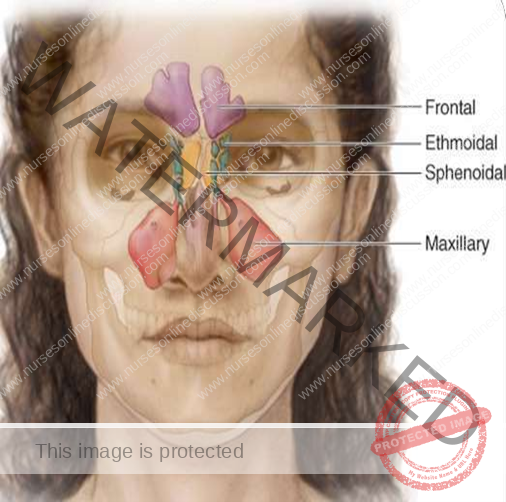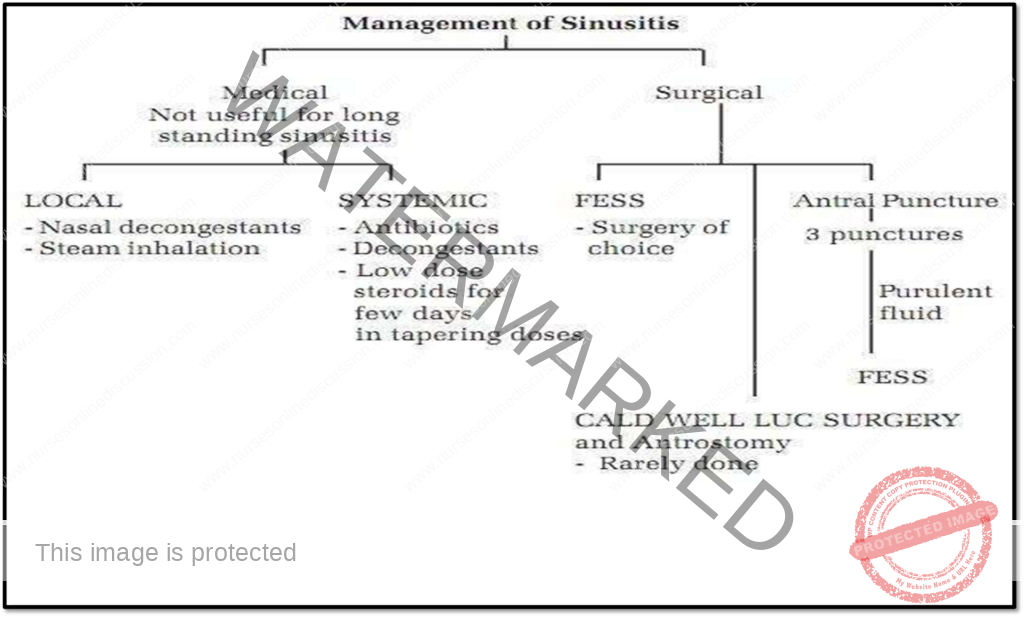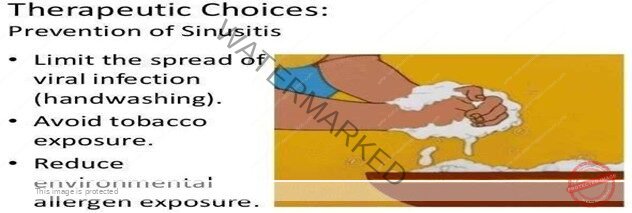Respiratory System Conditions
Subtopic:
Sinusitis

Anatomy and physiology of the sinuses
- Sinuses
- Maxillary, frontal, ethmoid, and sphenoid
- The sinuses are spaces in the bones of the skull; they are lined with mucous membrane and filled with
- Maxillary,
- Frontal,
- Ethmoidal,
- sphenoidal
Functions of Sinuses
- Speech
- Lighten the skull
- Drain tears from the eyes (nasolacrimal ducts)
Sinusitis
- Sinusitis is an inflammation, or swelling, of the tissue lining the sinuses. Normally, sinuses are filled with air, but when sinuses become blocked and filled with
- Just a Cold … at First
- Sinusitis usually starts with inflammation triggered by a cold, allergy attack, or irritant. But it may not end there. Colds, allergies, and irritants make sinus tissues swell.
Etiology/pathophysiology of Sinusitis
- 32 million people suffer from at least one episode of sinusitis each year.
- Most often the maxillary and frontal s
- Acute maxillary sinusitis may follow viral respiratory infection
- Most common organisms are:
- Staphylococcus pneumoniae .
- Haemophilus influenzae .
- Diplococcusand bacteroides
Predispose factors :
- Common cold.
- Common cold.Allergic rhinitis(swelling of the lining of the nose).Nasal polyps (small growths in the lining of the nose)
- Deviated septum(a shift in the nasal cavity).
Types of Sinusitis
Here are different types of sinusitis, including:
- Acute sinusitis: A sudden onset of cold-like symptoms such as runny, stuffy nose and facial pain that does not go away after 10 to 14 days. Acute sinusitis typically lasts 4 weeks or less.
- Subacute sinusitis: An inflammation lasting 4 to 8 weeks.
- Chronic sinusitis: A condition characterized by sinus inflammation symptoms lasting 8 weeks or longer.
- Recurrent sinusitis: Several attacks within a year
Clinical manifestations/assessment
- Most people have a stuffy nose and pain orpressure in several locations around the face or teeth. (heaviness over the affected area)
- When maxillary sinuses affected, pain may seem like a toothache .
- There’s usually a nasal discharge that may be yellow, green, or Clear
- Fatigue
- Decreased sense of smell and/or taste, sore throat, bad breath,
- Purulent drainage from the
- Headache is common, especially in the morning .
- Fever may be present; white blood cell count may be
- Cough in the chronic sinusitis
Complications
- Meningitis, brain abscess
- Osteomyelitis
- Orbital cellulitis
Assessment and Diagnostic Findings
A careful history and physical examination are Peformed
There may be tenderness to palpation over the infected sinus area. The sinuses are percussed using the index finger, tapping lightly to determine if the patient experiences pain.
Diagnostic tests
- Biopsy & Culture
- Sinus x-
- Computed tomography scanning
- MRI
Transillumination of the sinus:
- Otoscope with transillumination attachment
- Completely darken the room
- Decreased light transmission suggests Sinusitis
Management of sinusitis
Goals of Sinusitis Treatment
- Alleviate sinusitis
- Keep the nasal passages
- Reduce sinus
- Eliminate the underlying cause of sinusitis
- Reduce the frequency of sinusitis
Management of sinusitis
- Nasal steroid sprays
- Analgesics, and antipyretics
- Twice-daily hot showers
- Increased fluid intake
- Humidifier
- Functional endoscopic sinus surgery (FESS) for chronic sinusitis

Management of sinusitis (Duration)
- Clinical improvement usually occurs within 48 to 72 hours of antimicrobial therapy.
- The antibiotic therapy should be continued for a minimum of 7 days after the symptoms’ have disappeared
- The average duration of treatment should be 10 days and often 2 weeks
Nursing Management
Because the patient usually performs care measures for sinusitis at home, nursing management consists mainly of patient teaching.

Nursing diagnoses
- Infection
- Acute Pain related to Sinusitis
- Knowledge, deficient related to disease
Nursing Management
The nurse instructs the patient and family members to:
- Increasing fluid intake
- Applying local heat (hot wet packs).
- Following the medication
- The nurse teaches the patient how to promote sinus drainage by increasing the environmental humidity (steam bath, hot shower, and facial sauna),
- Instructions on the early signs of a sinus infection are provided and preventive
Preventing Sinusitis

- Keep sinuses moist — use saline sprays, nasal lubricant sprays, or nasal irrigation often.
- Avoid very dry indoor
- Avoid exposure to irritants, such as cigarette smoke or strong chemical
Get in Touch
(+256) 790 036 252
(+256) 748 324 644
Info@nursesonlinediscussion.com
Kampala ,Uganda
© 2025 Nurses online discussion. All Rights Reserved Design & Developed by Opensigma.co
×

